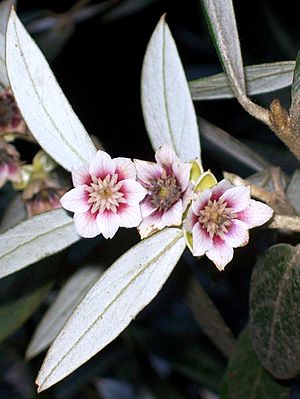Southern sassafras facts for kids
Quick facts for kids Southern sassafras |
|
|---|---|
 |
|
| Atherosperma - near Orbost, Victoria | |
| Scientific classification | |
| Genus: |
Atherosperma
|
| Species: |
moschatum
|
| Subspecies | |
|
|
The Atherosperma moschatum, often called the southern sassafras or blackheart sassafras, is an evergreen tree. This means it keeps its leaves all year round. It grows naturally in the cool temperate rainforests of Tasmania, Victoria, and New South Wales in Australia.
It is very common in the rainforests of Tasmania and Victoria. However, it is harder to find in the higher parts of eastern New South Wales. The most northern place it grows is at Mount Grundy, which is west of Port Macquarie.
Contents
Naming the Southern Sassafras
A French scientist named Jacques Labillardière first described the southern sassafras in 1806. For a long time, it was the only tree in its group, called Atherosperma.
The name Atherosperma comes from two old Greek words. Ather means "awn" (like a bristle), and sperma means "seed". This refers to the tiny hairs found on the tree's fruit. The second part of its name, moschatum, is a Latin word meaning "musk-scented". This describes the lovely smell of its bark.
The southern sassafras belongs to a small plant family called Atherospermataceae. Other Australian rainforest trees, like the yellow sassafras (Doryphora sassafras), are also in this family. Its closest relative is a tree called Nemuaron, which only grows in New Caledonia.
What the Tree Looks Like
The southern sassafras is a small to medium-sized tree. It usually grows to be about 6 to 25 meters (20 to 82 feet) tall. But in Tasmania, it can grow much taller, sometimes over 40 meters (130 feet) high. It can also become very wide, up to 1 meter (3 feet) across.
You can often spot this tree by its cone shape. It also has pale green leaves and a pleasant, fresh smell.
Bark and Leaves
The bark of the southern sassafras is grey to light brown. It has many small bumps and ridges called lenticels. These help the tree breathe.
Its leaves are usually 3 to 10 centimeters (1 to 4 inches) long and 8 to 25 millimeters (0.3 to 1 inch) wide. The edges of the leaves have rough, tooth-like shapes. However, some trees in northern areas, like Monga National Park and the Blue Mountains, have narrower leaves with smoother edges.
All parts of the tree – the leaves, small branches, and flowers – have a lovely nutmeg-like scent.
Flowers and Fruit
The flowers of the southern sassafras appear in winter. They hang downwards to protect themselves from rain and snow. The flowers have white petals and a yellow center. Sometimes, the center can also be maroon.
The fruit capsules ripen and open around January. They release light, feathery seeds that are carried away by the wind. It can be tricky to grow new trees from these seeds. However, many new seedlings can sometimes appear unexpectedly.
Where the Southern Sassafras Lives
The southern sassafras grows from the Tia River, west of Port Macquarie in New South Wales, all the way through Victoria and Tasmania.
It is found in wet areas like gullies and creek beds. These are usually in high-altitude temperate rainforests. It often grows alongside other trees like the southern beeches (from the genus Nothofagus) and the mountain quandong (Elaeocarpus holopetalus).
How Lichens Live on the Tree
The southern sassafras has smooth bark that does not peel off every year. This makes it a great home for many types of lichen.
Scientists studied these trees in Errinundra National Park. They found 54 different kinds of lichen living on the sassafras trees. One type, Pannaria microphyllizans, was found very often. These rainforest areas are important safe places for lichen species. They are protected from fires that often happen in nearby eucalyptus forests.
Uses of Southern Sassafras

The wood from the southern sassafras is very popular. People use it for wall panels, turning on a lathe, and making musical instruments. It is also used for special items like carvings, dishes, and small boxes for tourists.
The wood often has attractive dark markings. These "blackheart" stains are caused by a fungus. This makes the timber look even more beautiful.
In the past, the springy wood was used to make clothes pegs. The scented bark can also be used to make a drink.
It is not very common to grow southern sassafras in gardens. This is because it needs a lot of moisture and shade to grow well. However, it has been planted in the British Isles, even as far north as Northern Ireland and Scotland.
See also
 In Spanish: Atherosperma para niños
In Spanish: Atherosperma para niños

